Loading AI tools
Species in mammal order Didelphimorphia From Wikipedia, the free encyclopedia
Didelphimorphia is an order of marsupial mammals. Members of this order are called didelphimorphs, or opossums. They are primarily found in South America, though some are found in Central America and Mexico and one, the Virginia opossum, ranges into the United States and Canada. They have a variety of sizes, shapes, and fur patterns, and range in size from the 6 cm (2 in) (plus 9 cm (4 in) tail) Kalinowski's mouse opossum to the 55 cm (22 in) (plus 54 cm (21 in) tail) Virginia opossum. Didelphimorphs are primarily found in forests, as well as savannas, shrublands, and grasslands. Almost no population estimates have been made for didelphimorph species, though the one-striped opossum is classified as Critically Endangered with a population of less than ten, Handley's slender opossum is also critically endangered, and the red-bellied gracile opossum is extinct, having last been seen in 1962.

The 93 extant species of Didelphimorphia are grouped into a single family, Didelphidae, which is divided into four subfamilies: Caluromyinae, containing four species in two genera; Glironiinae, containing a single species; Hyladelphinae, also with a single species; and Didelphinae, containing 87 species split between 14 genera. Over one hundred extinct Didelphimorph species have been discovered, though due to ongoing research and discoveries the exact number and categorization is not fixed.[1]
| Conservation status | |
|---|---|
| EX | Extinct (1 species) |
| EW | Extinct in the wild (0 species) |
| CR | Critically Endangered (2 species) |
| EN | Endangered (0 species) |
| VU | Vulnerable (6 species) |
| NT | Near threatened (3 species) |
| LC | Least concern (67 species) |
| Other categories | |
| DD | Data deficient (14 species) |
| NE | Not evaluated (0 species) |
Conservation status codes listed follow the International Union for Conservation of Nature (IUCN) Red List of Threatened Species. Range maps are provided wherever possible; if a range map is not available, a description of the didelphimorph's range is provided. Ranges are based on the IUCN Red List for that species unless otherwise noted. All extinct species or subspecies listed alongside extant species went extinct after 1500 CE, and are indicated by a dagger symbol "†".
The order Didelphimorphia consists of one family, Didelphidae, which is divided into the subfamilies Caluromyinae, Glironiinae, Hyladelphinae, and Didelphinae. Caluromyinae contains 4 species in 2 genera, Glironiinae and Hyladelphinae each contain a single species, and Didelphinae contains 87 species in 14 genera, as well as the extinct red-bellied gracile opossum, which was last seen in 1962. Many of these species are further subdivided into subspecies. This does not include hybrid species or extinct prehistoric species.[2][3]
Family Didelphidae
The following classification is based on the taxonomy described by Mammal Species of the World (2005), with augmentation by generally accepted proposals made since using molecular phylogenetic analysis, as supported by both the IUCN and the American Society of Mammalogists.[4][5]
| Common name | Scientific name and subspecies | Range | Size and ecology | IUCN status and estimated population |
|---|---|---|---|---|
| Bare-tailed woolly opossum | C. philander (Linnaeus, 1758) Four subspecies
|
Eastern and northeastern South America |
Size: 16–28 cm (6–11 in) long, plus 25–41 cm (10–16 in) tail[6] Habitat: Forest[7] Diet: Fruit, as well as gum, nectar, small vertebrates, and invertebrates[7] |
LC
|
| Brown-eared woolly opossum | C. lanatus (Olfers, 1818) Four subspecies
|
Central and northwestern South America |
Size: 20–32 cm (8–13 in) long, plus 33–44 cm (13–17 in) tail[8] Habitat: Forest[9] Diet: Fruit, invertebrates, and some small vertebrates, as well as nectar and flowers[9] |
LC
|
| Derby's woolly opossum | C. derbianus (Waterhouse, 1841) Six subspecies
|
Central American and northwestern South America |
Size: 22–30 cm (9–12 in) long, plus 38–45 cm (15–18 in) tail[10] Habitat: Forest[11] Diet: Fruit, seeds, leaves, soft vegetables, insects, and other small invertebrates[11] |
LC
|
| Common name | Scientific name and subspecies | Range | Size and ecology | IUCN status and estimated population |
|---|---|---|---|---|
| Black-shouldered opossum
|
C. irrupta Sanborn, 1951 |
West-central South America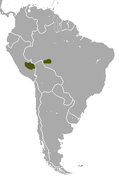 |
Size: 25–33 cm (10–13 in) long, plus 31–34 cm (12–13 in) tail[12] Habitat: Forest[13] Diet: Flowers and fruit, as well as small rodents[13] |
LC
|
| Common name | Scientific name and subspecies | Range | Size and ecology | IUCN status and estimated population |
|---|---|---|---|---|
| Chacoan pygmy opossum
|
C. formosa (Shamel, 1930) |
Northeastern Argentina |
Size: About 7 cm (3 in) long, plus 6 cm (2 in) tail[14] Habitat: Shrubland[15] Diet: Unknown[14] |
NT
|
| Common name | Scientific name and subspecies | Range | Size and ecology | IUCN status and estimated population |
|---|---|---|---|---|
| Water opossum | C. minimus (Zimmermann, 1780) Four subspecies
|
Central America, northern South America, southeastern South America |
Size: 27–40 cm (11–16 in) long, plus 30–43 cm (12–17 in) tail[16] Habitat: Forest and inland wetlands[17] Diet: Fish, crabs, other crustaceans, and insects, as well as frogs[17] |
LC
|
| Common name | Scientific name and subspecies | Range | Size and ecology | IUCN status and estimated population |
|---|---|---|---|---|
| Agricola's gracile opossum | C. agricolai (Moojen, 1943) |
Eastern Brazil |
Size: 8–9 cm (3–4 in) long, plus 10–11 cm (4 in) tail[18] Habitat: Forest and shrubland[19] Diet: Unknown |
DD
|
| Chacoan gracile opossum
|
C. chacoensis (Tate, 1931) |
Southern South America |
Size: 8–10 cm (3–4 in) long, plus 9–13 cm (4–5 in) tail[18] Habitat: Forest and grassland[20] Diet: Unknown fruit and insects[21] |
LC
|
| Guahiba gracile opossum
|
C. guahybae (Tate, 1931) |
Southern Brazil |
Size: About 9 cm (4 in) long, plus 11 cm (4 in) tail[18] Habitat: Forest and grassland[22] Diet: Unknown |
DD
|
| Red-bellied gracile opossum†
|
C. ignitus Díaz, Flores, Barquez, 2002 |
Northwestern Argentina | Size: About 11 cm (4 in) long, plus 12 cm (5 in) tail[18] Habitat: Forest[23] Diet: Unknown |
EX
|
| Unduavi gracile opossum
|
C. unduaviensis (Shamel, 1930) |
Northern Bolivia |
Size: 9–13 cm (4–5 in) long, plus 11–14 cm (4–6 in) tail[18] Habitat: Forest, grassland, and inland wetlands[24] Diet: Unknown |
DD
|
| Common name | Scientific name and subspecies | Range | Size and ecology | IUCN status and estimated population |
|---|---|---|---|---|
| Andean white-eared opossum | D. pernigra J. A. Allen, 1900 |
Northwestern South America |
Size: 30–50 cm (12–20 in) long, plus 25–54 cm (10–21 in) tail[25] Habitat: Forest, shrubland, and grassland[26] Diet: Small vertebrates, carrion, invertebrates, and plants[25] |
LC
|
| Big-eared opossum | D. aurita (Wied-Neuwied, 1826) |
Eastern South America |
Size: 30–50 cm (12–20 in) long, plus 25–54 cm (10–21 in) tail[25] Habitat: Forest and shrubland[27] Diet: Arthropods and fruit, as well as other invertebrates and small vertebrates[28] |
LC
|
| Common opossum | D. marsupialis Linnaeus, 1758 Two subspecies
|
Central American and northern South America |
Size: 26–43 cm (10–17 in) long, plus 40 cm (16 in) tail[29] Habitat: Forest and shrubland[30] Diet: Omnivorous; eats invertebrates, vertebrates, leaves, fruit, nectar, and carrion[29] |
LC
|
| Guianan white-eared opossum
|
D. imperfecta Mondolfi, Hernández, 1984 |
Northern South America |
Size: 30–50 cm (12–20 in) long, plus 25–54 cm (10–21 in) tail[25] Habitat: Forest[31] Diet: Omnivorous; primarily fruit and insects[31] |
LC
|
| Virginia opossum | D. virginiana Kerr, 1792 Four subspecies
|
North America and Central America |
Size: 33–55 cm (13–22 in) long, plus 25–54 cm (10–21 in) tail[32] Habitat: Forest and shrubland[33] Diet: Omnivorous, including vertebrates, invertebrates, plant material, fruits, grains and carrion[32] |
LC
|
| White-eared opossum | D. albiventris Lund, 1840 |
Eastern and southern South America |
Size: 30–50 cm (12–20 in) long, plus 25–54 cm (10–21 in) tail[25] Habitat: Forest, savanna, and shrubland[34] Diet: Small vertebrates, carrion, invertebrates, and plants[25] |
LC
|
| Common name | Scientific name and subspecies | Range | Size and ecology | IUCN status and estimated population |
|---|---|---|---|---|
| Aceramarca gracile opossum
|
G. aceramarcae (Tate, 1931) |
Western Aouth America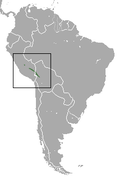 |
Size: About 11 cm (4 in) long, plus 14 cm (6 in) tail[35] Habitat: Forest[36] Diet: Fruit, insects and other small invertebrates[36] |
LC
|
| Agile gracile opossum | G. agilis (Burmeister, 1854) |
Central South America |
Size: 8–12 cm (3–5 in) long, plus 10–16 cm (4–6 in) tail[37] Habitat: Forest[38] Diet: Insects and fruit[39] |
LC
|
| Brazilian gracile opossum | G. microtarsus (Wagner, 1842) Two subspecies
|
Southeastern South America |
Size: About 10 cm (4 in) long, plus 13 cm (5 in) tail[40] Habitat: Forest[41] Diet: Insects, other invertebrates, and fruit[40] |
LC
|
| Emilia's gracile opossum
|
G. emiliae (Thomas, 1909) |
Scattered northern South America |
Size: About 8 cm (3 in) long, plus 14 cm (6 in) tail[42] Habitat: Forest[43] Diet: Believed to be insects and fruit[42] |
DD
|
| Northern gracile opossum
|
G. marica (Thomas, 1898) |
Northern South America |
Size: About 10 cm (4 in) long, plus 13 cm (5 in) tail[44] Habitat: Forest and grassland[45] Diet: Believed to be insects and fruit[44] |
LC
|
| Wood sprite gracile opossum
|
G. dryas (Thomas, 1898) |
Northern South America |
Size: About 11 cm (4 in) long, plus 14 cm (6 in) tail[46] Habitat: Forest[47] Diet: Believed to be insects and fruit[46] |
LC
|
| Common name | Scientific name and subspecies | Range | Size and ecology | IUCN status and estimated population |
|---|---|---|---|---|
| Patagonian opossum
|
L. halli (Thomas, 1921) |
Southern South America |
Size: 13–15 cm (5–6 in) long, plus 8–10 cm (3–4 in) tail[48] Habitat: Shrubland, grassland, and desert[49] Diet: Invertebrates, as well as birds, reptiles, and fruit[48] |
LC
|
| Common name | Scientific name and subspecies | Range | Size and ecology | IUCN status and estimated population |
|---|---|---|---|---|
| Big lutrine opossum | L. crassicaudata (Desmarest, 1804) Two subspecies
|
Scattered South America (Massoia's lutrine opossum in red) |
Size: 26–35 cm (10–14 in) long, plus 24–30 cm (9–12 in) tail[50] Habitat: Forest, grassland, and inland wetlands[51] Diet: Omnivorous; crabs, beetles, amphibians, birds, seeds, and vegetation, as well as other invertebrates, fish, and small mammals[50] |
LC
|
| Massoia's lutrine opossum
|
L. massoia Martínez-Lanfranco, Flores, Jayat, D'Elía, 2014 |
South-central South America (big lutrine opossum in green) |
Size: 18–24 cm (7–9 in) long, plus 20–26 cm (8–10 in) tail[52] Habitat: Forest and grassland[53] Diet: Small mammals, fish, and invertebrates, as well as bird eggs and fruit[52] |
LC
|
| Common name | Scientific name and subspecies | Range | Size and ecology | IUCN status and estimated population |
|---|---|---|---|---|
| Alston's mouse opossum | M. alstoni (Allen, 1900) |
Central America, northwestern tip of South America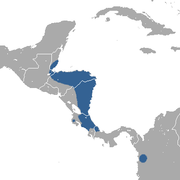 |
Size: 18–20 cm (7–8 in) long, plus 24–28 cm (9–11 in) tail[54] Habitat: Forest[55] Diet: Insects, small vertebrates, and fruit[55] |
LC
|
| Bare-tailed woolly mouse opossum
|
M. regina Thomas, 1924 |
Western South America | Size: 15–21 cm (6–8 in) long, plus 21–30 cm (8–12 in) tail[56] Habitat: Forest[56] Diet: Insects and fruit, as well as nectar, small vertebrates, and eggs[57] |
NE
|
| Guajira mouse opossum
|
M. xerophila Handley, Gordon, 1979 |
Northern South America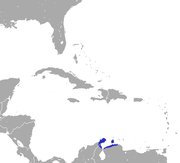 |
Size: 8–16 cm (3–6 in) long, plus 10–20 cm (4–8 in) tail[58] Habitat: Forest and shrubland[59] Diet: Insects and fruit, as well as lizards, bird eggs, and small rodents[59] |
VU
|
| Heavy-browed mouse opossum
|
M. andersoni Pine, 1972 |
Peru |
Size: 8–22 cm (3–9 in) long, plus 12–27 cm (5–11 in) tail[57] Habitat: Forest[60] Diet: Insects, as well as fruit[61] |
DD
|
| Linnaeus's mouse opossum | M. murina (Linnaeus, 1758) |
Northern and eastern South America |
Size: 11–15 cm (4–6 in) long, plus 13–21 cm (5–8 in) tail[62] Habitat: Forest[63] Diet: Insects, small animals, and fruit[63] |
LC
|
| Little woolly mouse opossum
|
M. phaea Thomas, 1899 |
Northwestern South America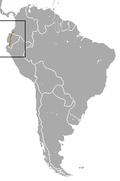 |
Size: 8–22 cm (3–9 in) long, plus 12–27 cm (5–11 in) tail[57] Habitat: Forest[64] Diet: Insects and fruit, as well as nectar, small vertebrates, and eggs[57] |
VU
|
| Mexican mouse opossum | M. mexicana Merriam, 1897 Three subspecies
|
Mexico and Central America |
Size: 9–17 cm (4–7 in) long, plus 13–23 cm (5–9 in) tail[58] Habitat: Forest and grassland[65] Diet: Insects and fruit, as well as small rodents, lizards, birds, and eggs[65] |
LC
|
| Quechuan mouse opossum
|
M. quichua Wagner, 1842 |
Western South America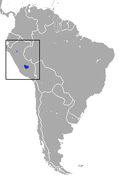 |
Size: 8–22 cm (3–9 in) long, plus 12–27 cm (5–11 in) tail[57] Habitat: Forest[66] Diet: Insects and fruit, as well as nectar, small vertebrates, and eggs[57] |
LC
|
| Red mouse opossum
|
M. rubra Tate, 1931 |
Western South America |
Size: 12–20 cm (5–8 in) long, plus 18–22 cm (7–9 in) tail[58] Habitat: Forest[67] Diet: Insects and fruit[68] |
DD
|
| Robinson's mouse opossum | M. robinsoni Bangs, 1898 Six subspecies
|
Northern South America and Central America |
Size: 8–22 cm (3–9 in) long, plus 10–22 cm (4–9 in) tail[58] Habitat: Forest and savanna[69] Diet: Fruit and insects[69] |
LC
|
| Rufous mouse opossum | M. lepida (Thomas, 1888) |
Northwestern South America |
Size: 8–22 cm (3–9 in) long, plus 12–27 cm (5–11 in) tail[57] Habitat: Forest[70] Diet: Insects and fruit[70] |
LC
|
| Tate's woolly mouse opossum | M. paraguayana Tate, 1931 Two subspecies
|
Southeastern South America | Size: 8–22 cm (3–9 in) long, plus 12–27 cm (5–11 in) tail[57] Habitat: Forest[71] Diet: Omnivorous and insectivorous[71] |
LC
|
| Tyler's mouse opossum
|
M. tyleriana Tate, 1931 |
Northern South America |
Size: 8–22 cm (3–9 in) long, plus 12–27 cm (5–11 in) tail[57] Habitat: Forest[72] Diet: Insects as well as fruit[73] |
DD
|
| White-bellied woolly mouse opossum
|
M. constantiae Thomas, 1904 |
Central South America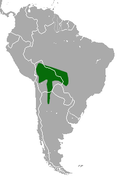 |
Size: 8–22 cm (3–9 in) long, plus 12–27 cm (5–11 in) tail[57] Habitat: Forest[74] Diet: Insects and fruit, as well as nectar, small vertebrates, and eggs[57] |
LC
|
| Woolly mouse opossum
|
M. demerarae Thomas, 1905 Four subspecies
|
Northeastern South America |
Size: 8–22 cm (3–9 in) long, plus 12–27 cm (5–11 in) tail[57] Habitat: Forest[75] Diet: Insects, small animals, fruit, and nectar[75] |
LC
|
| Common name | Scientific name and subspecies | Range | Size and ecology | IUCN status and estimated population |
|---|---|---|---|---|
| Andean Slender Mouse Opossum
|
M. caucae (Thomas, 1900) |
Northwestern South America | Size: 9–17 cm (4–7 in) long, plus 10–22 cm (4–9 in) tail[76] Habitat: Forest[77] Diet: Insects and fruit[76] |
LC
|
| Bishop's slender opossum
|
M. bishopi (Pine, 1981) |
Central South America |
Size: 9–12 cm (4–5 in) long, plus 11–16 cm (4–6 in) tail[78] Habitat: Forest[79] Diet: Insects and fruit[76] |
LC
|
| Brazilian slender opossum
|
M. paulensis (Tate, 1931) |
Southeastern Brazil |
Size: 9–17 cm (4–7 in) long, plus 10–22 cm (4–9 in) tail[76] Habitat: Forest[80] Diet: Insects and fruit[76] |
LC
|
| Creighton's slender opossum
|
M. creightoni Voss, Tarifa, Yensen, 2004 |
Zongo River valley in Bolivia |
Size: 9–17 cm (4–7 in) long, plus 10–22 cm (4–9 in) tail[76] Habitat: Forest[81] Diet: Insects and fruit[76] |
DD
|
| Delicate slender opossum
|
M. parvidens (Tate, 1931) |
Northern South America |
Size: 9–11 cm (4 in) long, plus 14–16 cm (6–6 in) tail[78] Habitat: Forest[82] Diet: Insects and fruit[76] |
LC
|
| Dusky slender opossum
|
M. fuscatus (Thomas, 1896) Two subspecies
|
Northern South America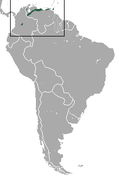 |
Size: 13–14 cm (5–6 in) long, plus 14–15 cm (6–6 in) tail[78] Habitat: Forest[83] Diet: Insects and fruit[76] |
DD
|
| Gray slender opossum | M. incanus (Lund, 1841) |
Eastern South America |
Size: 9–17 cm (4–7 in) long, plus 10–22 cm (4–9 in) tail[76] Habitat: Forest[84] Diet: Insects and fruit[76] |
LC
|
| Handley's slender opossum
|
M. handleyi (Pine, 1981) |
Central Columbia |
Size: 10–13 cm (4–5 in) long, plus 12–15 cm (5–6 in) tail[78] Habitat: Forest[85] Diet: Insects and fruit[76] |
CR
|
| Junin slender opossum
|
M. juninensis (Tate, 1931) |
Central Peru |
Size: 9–11 cm (4 in) long, plus 12–14 cm (5–6 in) tail[78] Habitat: Forest[86] Diet: Insects and fruit[76] |
VU
|
| Narrow-headed slender opossum
|
M. cracens Handley, Gordon, 1979 |
Northern South America |
Size: 9–17 cm (4–7 in) long, plus 10–22 cm (4–9 in) tail[76] Habitat: Forest[87] Diet: Insects and fruit[76] |
DD
|
| Neblina slender opossum
|
M. neblina Gardner, 1990 |
Northwestern South America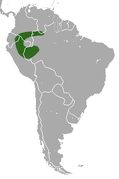 |
Size: 9–17 cm (4–7 in) long, plus 10–22 cm (4–9 in) tail[76] Habitat: Forest[88] Diet: Insects and fruit[76] |
LC
|
| Panama slender opossum
|
M. invictus (Goldman, 1921) |
Panama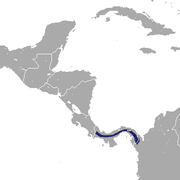 |
Size: 10–12 cm (4–5 in) long, plus 12–15 cm (5–6 in) tail[78] Habitat: Forest[89] Diet: Insects and fruit[76] |
LC
|
| Pantepui slender opossum
|
M. pakaraimae Voss, Lim, Díaz-Nieto, Jansa, 2013 |
Northern South America | Size: 10–12 cm (4–5 in) long, plus 15–17 cm (6–7 in) tail[78] Habitat: Forest[90] Diet: Insects and fruit[76] |
VU
|
| Pinheiro's slender opossum
|
M. pinheiroi (Pine, 1981) |
Northern South America |
Size: 8–13 cm (3–5 in) long, plus 12–16 cm (5–6 in) tail[78] Habitat: Forest[91] Diet: Insects and fruit[76] |
LC
|
| Spectacled slender opossum
|
M. ocellatus (Tate, 1931) |
Bolivia | Size: 9–17 cm (4–7 in) long, plus 10–22 cm (4–9 in) tail[76] Habitat: Forest[92] Diet: Insects and fruit[76] |
LC
|
| Tschudi's slender opossum
|
M. impavidus Tschudi, 1844 |
Northwestern South America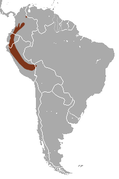 |
Size: 9–17 cm (4–7 in) long, plus 10–22 cm (4–9 in) tail[76] Habitat: Forest[93] Diet: Insects and fruit[76] |
LC
|
| White-bellied slender opossum | M. noctivagus (Tschudi, 1844) |
Western South America |
Size: 9–17 cm (4–7 in) long, plus 10–22 cm (4–9 in) tail[76] Habitat: Forest[94] Diet: Insects and fruit[76] |
LC
|
| Common name | Scientific name and subspecies | Range | Size and ecology | IUCN status and estimated population |
|---|---|---|---|---|
| Brown four-eyed opossum | M. nudicaudatus (Geoffroy, 1803) Four subspecies
|
South America and Central America |
Size: 19–31 cm (7–12 in) long, plus 19–39 cm (7–15 in) tail[95] Habitat: Forest and shrubland[96] Diet: Insects and other invertebrates, as well as fruit, seeds, and small mammals[95] |
LC
|
| Common name | Scientific name and subspecies | Range | Size and ecology | IUCN status and estimated population |
|---|---|---|---|---|
| Amazonian red-sided opossum
|
M. glirina (Wagner, 1842) |
Central South America |
Size: 7–20 cm (3–8 in) long, plus 4–11 cm (2–4 in) tail[97] Habitat: Forest[98] Diet: Small vertebrates, insects, carrion, seeds, and fruit[97] |
LC
|
| Emilia's short-tailed opossum
|
M. emiliae (Thomas, 1912) |
Central South America |
Size: 7–20 cm (3–8 in) long, plus 4–11 cm (2–4 in) tail[97] Habitat: Forest[99] Diet: Small vertebrates, insects, carrion, seeds, and fruit[97] |
LC
|
| Gray short-tailed opossum | M. domestica (Wagner, 1842) |
Central and eastern South America |
Size: 10–15 cm (4–6 in) long, plus tail[100] Habitat: Forest, shrubland, and grassland[101] Diet: Insects, fruits, and small animals[100] |
LC
|
| Handley's short-tailed opossum
|
M. handleyi Solari, 2007 |
Central South America | Size: 7–20 cm (3–8 in) long, plus 4–11 cm (2–4 in) tail[97] Habitat: Forest[102] Diet: Small vertebrates, insects, carrion, seeds, and fruit[97] |
DD
|
| Hooded red-sided opossum
|
M. palliolata (Osgood, 1914) |
Northern South America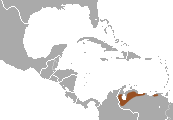 |
Size: 7–20 cm (3–8 in) long, plus 4–11 cm (2–4 in) tail[97] Habitat: Forest[103] Diet: Small vertebrates, insects, carrion, seeds, and fruit[97] |
LC
|
| Ihering's three-striped opossum
|
M. iheringi (Thomas, 1888) |
Eastern South America |
Size: 7–20 cm (3–8 in) long, plus 4–11 cm (2–4 in) tail[97] Habitat: Forest and unknown[104] Diet: Small vertebrates, insects, carrion, seeds, and fruit[97] |
DD
|
| Long-nosed short-tailed opossum | M. scalops (Thomas, 1888) |
Eastern South America |
Size: 7–20 cm (3–8 in) long, plus 4–11 cm (2–4 in) tail[97] Habitat: Forest[105] Diet: Small vertebrates, insects, carrion, seeds, and fruit[97] |
LC
|
| Northern red-sided opossum | M. brevicaudata (Erxleben, 1777) |
Northern South America |
Size: 7–20 cm (3–8 in) long, plus 4–11 cm (2–4 in) tail[97] Habitat: Forest[106] Diet: Small vertebrates, insects, carrion, seeds, and fruit[97] |
LC
|
| Northern three-striped opossum | M. americana (Müller, 1776) |
Eastern South America |
Size: 7–20 cm (3–8 in) long, plus 4–11 cm (2–4 in) tail[97] Habitat: Forest and shrubland[107] Diet: Small vertebrates, insects, carrion, seeds, and fruit[97] |
LC
|
| One-striped opossum
|
M. unistriata (Wagner, 1842) |
Southeastern South America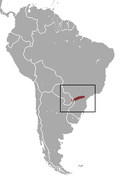 |
Size: 7–20 cm (3–8 in) long, plus 4–11 cm (2–4 in) tail[97] Habitat: Forest[108] Diet: Small vertebrates, insects, carrion, seeds, and fruit[97] |
CR
|
| Osgood's short-tailed opossum
|
M. osgoodi Doutt, 1938 |
Western South America |
Size: 7–20 cm (3–8 in) long, plus 4–11 cm (2–4 in) tail[97] Habitat: Forest[109] Diet: Small vertebrates, insects, carrion, seeds, and fruit[97] |
LC
|
| Peruvian short-tailed opossum
|
M. peruviana (Osgood, 1913) |
Peru | Size: 7–20 cm (3–8 in) long, plus 4–11 cm (2–4 in) tail[97] Habitat: Forest[110] Diet: Small vertebrates, insects, carrion, seeds, and fruit[97] |
LC
|
| Pygmy short-tailed opossum
|
M. kunsi Pine, 1975 |
Central South America |
Size: 7–20 cm (3–8 in) long, plus 4–11 cm (2–4 in) tail[97] Habitat: Forest and savanna[111] Diet: Small vertebrates, insects, carrion, seeds, and fruit[97] |
LC
|
| Reig's opossum
|
M. reigi Lew, Pérez-Hernández, 2004 |
Northern South America |
Size: 7–20 cm (3–8 in) long, plus 4–11 cm (2–4 in) tail[97] Habitat: Forest[112] Diet: Small vertebrates, insects, carrion, seeds, and fruit[97] |
VU
|
| Ronald's opossum
|
M. ronaldi Solari, 2004 |
Western South America |
Size: 7–20 cm (3–8 in) long, plus 4–11 cm (2–4 in) tail[97] Habitat: Forest[113] Diet: Small vertebrates, insects, carrion, seeds, and fruit[97] |
LC
|
| Sepia short-tailed opossum
|
M. adusta (Thomas, 1897) |
Northwestern South America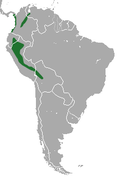 |
Size: 9–13 cm (4–5 in) long, plus 4–7 cm (2–3 in) tail[114] Habitat: Forest[115] Diet: Invertebrates, fruits and small vertebrates[114] |
LC
|
| Yellow-sided opossum | M. dimidiata (Wagner, 1847) |
Southern South America |
Size: 7–20 cm (3–8 in) long, plus 4–11 cm (2–4 in) tail[97] Habitat: Forest, grassland, and inland wetlands[116] Diet: Small vertebrates, insects, carrion, seeds, and fruit[97] |
LC
|
| Common name | Scientific name and subspecies | Range | Size and ecology | IUCN status and estimated population |
|---|---|---|---|---|
| Anderson's four-eyed opossum | P. andersoni (Osgood, 1913) |
Northwestern South America |
Size: 25–35 cm (10–14 in) long, plus 25–35 cm (10–14 in) tail[117] Habitat: Forest[118] Diet: Insects, other small invertebrates, eggs, and fruit[117] |
LC
|
| Deltaic four-eyed opossum
|
P. deltae Lew, Pérez-Hernández, Ventura, 2006 |
Northern South America |
Size: 20–38 cm (8–15 in) long, plus 19–36 cm (7–14 in) tail[119] Habitat: Forest and inland wetlands[120] Diet: Small mammals, other small vertebrates, eggs, insects, other invertebrates, fruit, and carrion[119] |
LC
|
| Gray four-eyed opossum | P. opossum (Linnaeus, 1758) Two subspecies
|
Northern and central South America and Central America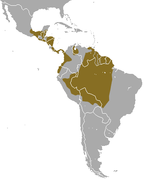 |
Size: 20–34 cm (8–13 in) long, plus 19–36 cm (7–14 in) tail[121] Habitat: Forest and shrubland[122] Diet: Omnivorous, including invertebrates, small animals, leaves, bark, seeds, nuts, nectar, and fruit[121] |
LC
|
| McIlhenny's four-eyed opossum
|
P. mcilhennyi Gardner, Patton, 1972 |
Central South America |
Size: 28–31 cm (11–12 in) long, plus 26–38 cm (10–15 in) tail[123] Habitat: Forest[124] Diet: Believed to be omnivorous[123] |
LC
|
| Southeastern four-eyed opossum
|
P. frenatus Olfers, 1818 |
 |
Size: 21–29 cm (8–11 in) long, plus 17–32 cm (7–13 in) tail[125] Habitat: Forest[126] Diet: Omnivorous, including flowers, fruit, invertebrates, and small vertebrates[126] |
LC
|
| Common name | Scientific name and subspecies | Range | Size and ecology | IUCN status and estimated population |
|---|---|---|---|---|
| Argentine fat-tailed mouse opossum
|
T. sponsorius (Thomas, 1921) |
Central South America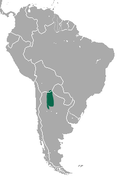 |
Size: 6–15 cm (2–6 in) long, plus 6–17 cm (2–7 in) tail[127] Habitat: Shrubland[128] Diet: Insects, as well as fruit and small vertebrates[127] |
LC
|
| Buff-bellied fat-tailed mouse opossum
|
T. venustus (Thomas, 1902) |
Central South America |
Size: 6–15 cm (2–6 in) long, plus 6–17 cm (2–7 in) tail[127] Habitat: Forest, savanna, and shrubland[129] Diet: Insects, as well as fruit and small vertebrates[127] |
DD
|
| Common fat-tailed mouse opossum
|
T. pusillus (Desmarest, 1804) |
Central South America |
Size: 7–12 cm (3–5 in) long, plus 8–14 cm (3–6 in) tail[130] Habitat: Forest and savanna[131] Diet: Insects, as well as fruit and small vertebrates[127] |
LC
|
| Dwarf fat-tailed mouse opossum
|
T. velutinus (Wagner, 1842) |
Eastern South America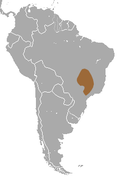 |
Size: 6–15 cm (2–6 in) long, plus 6–17 cm (2–7 in) tail[127] Habitat: Forest, savanna, shrubland, and grassland[132] Diet: Insects, as well as fruit and small vertebrates[127] |
NT
|
| Elegant fat-tailed mouse opossum | T. elegans (Waterhouse, 1839) |
Southwestern South America |
Size: 6–15 cm (2–6 in) long, plus 6–17 cm (2–7 in) tail[127] Habitat: Forest and shrubland[133] Diet: Insects, as well as fruit and small vertebrates[127] |
LC
|
| Karimi's fat-tailed mouse opossum
|
T. karimii (Petter, 1968) |
Central South America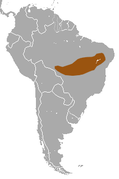 |
Size: 6–15 cm (2–6 in) long, plus 6–17 cm (2–7 in) tail[127] Habitat: Forest and savanna[134] Diet: Insects, as well as fruit and small vertebrates[127] |
VU
|
| Paraguayan fat-tailed mouse opossum
|
T. macrurus (Olfers, 1818) |
Central South America |
Size: 6–15 cm (2–6 in) long, plus 6–17 cm (2–7 in) tail[127] Habitat: Forest, savanna, and shrubland[135] Diet: Insects, as well as fruit and small vertebrates[127] |
NT
|
| Tate's fat-tailed mouse opossum
|
T. tatei (Handley, 1957) |
Western South America |
Size: 6–15 cm (2–6 in) long, plus 6–17 cm (2–7 in) tail[127] Habitat: Shrubland and desert[136] Diet: Insects, as well as fruit and small vertebrates[127] |
DD
|
| White-bellied fat-tailed mouse opossum
|
T. pallidior (Thomas, 1902) |
Southwestern South America |
Size: 7–11 cm (3–4 in) long, plus 9–12 cm (4–5 in) tail[137] Habitat: Shrubland and desert[138] Diet: Arthropods, as well as leaves, fruit, and seeds[137] |
LC
|
| Common name | Scientific name and subspecies | Range | Size and ecology | IUCN status and estimated population |
|---|---|---|---|---|
| Grayish mouse opossum | T. canescens (Allen, 1893) |
Southern Mexico | Size: 8–15 cm (3–6 in) long, plus 9–17 cm (4–7 in) tail[139] Habitat: Forest and shrubland[140] Diet: Insects and fruit[139] |
LC
|
| Common name | Scientific name and subspecies | Range | Size and ecology | IUCN status and estimated population |
|---|---|---|---|---|
| Bushy-tailed opossum
|
G. venusta Thomas, 1912 |
West-central South America |
Size: 13–20 cm (5–8 in) long, plus 19–23 cm (7–9 in) tail[141] Habitat: Forest[142] Diet: Insects, seeds, fruit, and eggs[142] |
LC
|
| Common name | Scientific name and subspecies | Range | Size and ecology | IUCN status and estimated population |
|---|---|---|---|---|
| Kalinowski's mouse opossum
|
H. kalinowskii (Hershkovitz, 1992) |
North-central South America |
Size: 6–10 cm (2–4 in) long, plus 9–12 cm (4–5 in) tail[143] Habitat: Forest[144] Diet: Unknown |
LC
|
Seamless Wikipedia browsing. On steroids.
Every time you click a link to Wikipedia, Wiktionary or Wikiquote in your browser's search results, it will show the modern Wikiwand interface.
Wikiwand extension is a five stars, simple, with minimum permission required to keep your browsing private, safe and transparent.